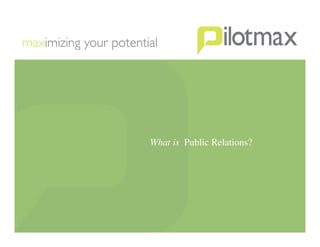What Is Pr
- 1. What is Public Relations?
- 2. Public RelationsâĶ âĒ Is a planned and sustained effort to establish and maintain mutual understanding between an organisation and its public - both internally and externally âĒ Includes everything that is calculated to improve a mutual understanding between an organisation and everyone it comes into contact with If the aim of public relations had to be summed up in only one word that word would be âĶREPUTATION.
- 3. Public RelationsâĶ âĒ Although not an end in itself, is a management tool which must be fitted into the whole framework of an organisationâs internal policy to encourage and protect positive reputation and provide a consistent, integrated message
- 4. Public Relations canâĶ âĒ Provide a means of communicating with potential customers, both trade and end-users âĒ Provide a means of communicating with specific market sectors âĒ Allow an organisation to educate the market on the benefits of its products âĒ Support above and below the line activity âĒ Generate qualitative and quantitative coverage across the target market âĒ Provide a means for the organisation to be a voice for the industry
- 5. Sponsorship Offices internal/external Annual report Promotions Direct mail Exhibitions Newsletters PUBLIC RELATIONS Customer service Advertising Employees training etc Media relations Brand/Product identity Corporate identity Research Every activity within an organisation affects its reputation â positively or negatively
- 6. Component parts of public relations programmes âĒ Strategic Consultancy âĒ Research & Evaluation âĒ Event Management âĒ Media Monitoring âĒ Newsletters âĒ Crisis Management âĒ Sponsorship âĒ Internal Communications âĒ Media Relations
- 7. Common media relations misconceptions âĒ Editorial coverage is guaranteed âĒ Editorial coverage can be secured by taking an advertisement âĒ Editorial coverage can be secured by taking the editor out for a long and expensive lunch âĒ Editors are desperate for copy to fill their blank pages
- 8. Common media relations misconceptions âĒ Editors will tell you if they are going to use your story âĒ A press release will not be changed or shortened âĒ Any publicity is good publicity âĒ Client/agency controls the editor âĒ Editorial can be seen prior to publication âĒ Editorial coverage is âfreeâ advertising
- 9. Communications methods used to educate the media One to one meetings Targeted stories Research Industry comment Pictures EDITOR News stories Case histories Feature support Tailor-made features Letters
- 10. The PR campaign must educate the Editors by creating and building Awareness Confidence Knowledge Respect INFORMATION UNIQUE SOLUTIONS EDITOR EDITORIAL COVERAGE
- 11. Only you can make PR happen! âĒ The editor does not know what you know âĒ Contact media with relevant information
- 12. PR problems âĒ Deadlines âĒ No guarantees âĒ Misquotes âĒ Interpretation âĒ Rewrites âĒ No pictures available
- 13. Types of media âĒ National and international newspapers âĒ Consumer magazines âĒ Broadcast media âĒ Business magazines âĒ Trade and technical media âĒ New media/On-line media
- 14. PR opportunities âĒ Press conference âĒ Press days (visits) âĒ Face to face meetings âĒ Exhibitions âĒ Press releases âĒ Personal telephone calls Remember â a picture is worth a 1000 words Photography is worth the investment
- 15. Implementing a Media Relations programme Identify business goals Specify audiences Identify messages/issues (including negative messages) Campaigns Achieve business goals Evaluate














